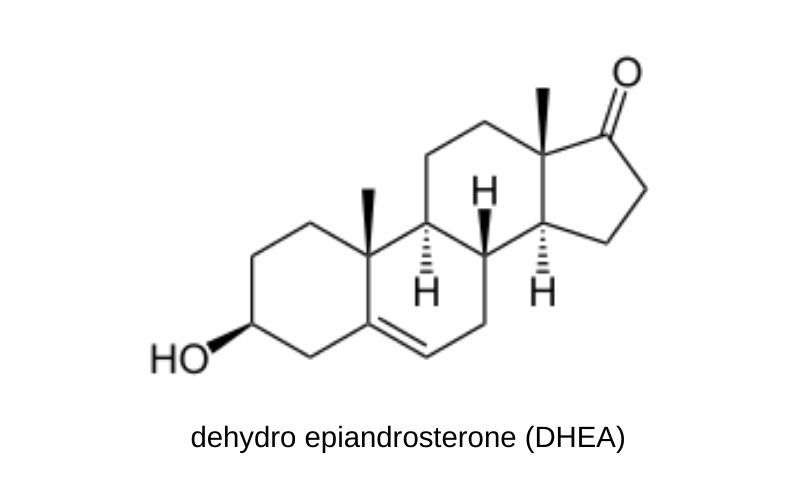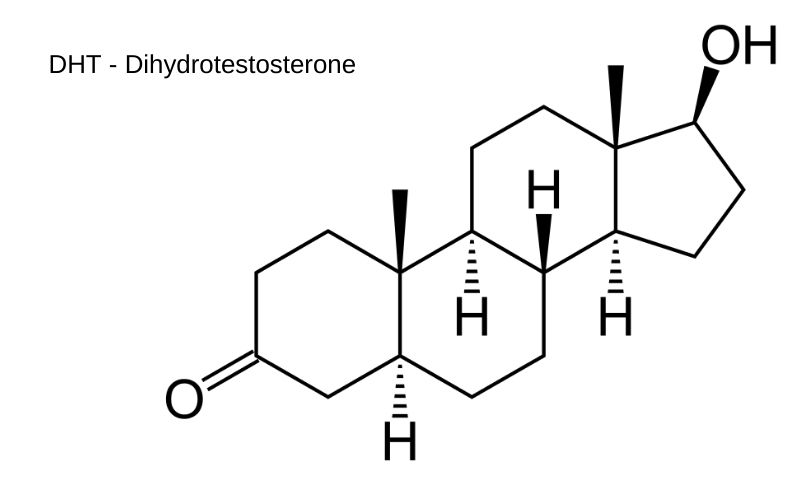Oral contraceptive pills to treat androgenetic alopecia in women
Although testosterone is considered to be a male hormone, it also occurs naturally in women. The exact roles of androgen over-production, activity, and androgen receptors in androgenetic alopecia in women are still unclear. Approximately 30 percent of a woman’s testosterone is produced in the ovaries; the other 70 percent is derived from the transformation of adrenal androgen precursors such as dehydro epiandrosterone (DHEA) and androstenedione, both of which decline inevitably with age.
5 alpha – Reductase is the enzyme responsible for the metabolism of testosterone to Dihydrotestosterone, commonly known as DHT. Compared to testosterone, DHT binds the androgen receptor with five times the tenacity of testosterone and is more potent in its ability to cause downstream activation.

dehydro epiandrosterone (DHEA) 
DHT Dihydrotestosterone – Androgen 
5 alpha – reductase enzymes
Considering the involvement of androgen receptors and 5 alpha – reductase in androgenetic alopecia, blocking them would be a logical approach to treatment. Over the years, several agents that target these mechanisms have been used, with varying success rates in men and women. This has led to the option and subsequent development of an agent which would produce both androgen receptor antagonism and decreased skin 5 alpha – reductase activity – a combination of an antiandrogenic progestogen with an estrogen. This combination has a major advantage over other treatment regimens in women in that it provides the contraceptive effect needed to safeguard against possible feminization of a male fetus.
Table of Contents
Different mechanisms by which contraceptive pills block androgens

- Since birth control pills inhibit the production of androgens, including testosterone, in a woman’s ovaries, they can be used to treat women’s androgenetic alopecia. Progesterone is a potent inhibitor of 5 -Reductase activity and androgen receptor binding.
- Progestins (synthetic form of the female sex hormone progesterone) in marketed oral contraceptive pills are more closely related structurally to testosterone and estrogen than to progesterone. These pills have estrogenic (inducing female hormonal activity) or androgenic (inducing development of male sex characteristics) or antiestrogenic (estrogen inhibiting) activity. A progestin can compete with testosterone and DHT for androgen receptor binding and, depending on its inherent androgenic properties, can act as an antagonist or agonist.
- Chlormadinone acetate, cyproterone acetate and dienogest are potent, orally active progestogens, which have antiandrogenic instead of partial androgenic activity. They act primarily by blocking androgen receptors in target organs, but also reduce the activity of skin 5a-reductase in sebaceous glands and hair follicles. Chlormadinone acetate and cyproterone acetate also suppress gonadotropin (a hormone that acts on the gonads to promote their function) secretion, thereby reducing ovarian and adrenal androgen production.
- Oral contraceptive pills also suppress ovulation (release of an egg from the ovary in females) and thus diminish the production of androgens by the ovaries.
- The most important protein for androgen binding is sex-hormone binding globulin (SHBG), a glycoprotein synthesized by the liver. Many studies show that SHBG levels co-relate inversely with the severity of the alopecia. The more potent androgens and estradiol are bound in the plasma to SHBG, although the binding affinities differ. In DHT the affinity is three times that of testosterone and nine times that of estradiol. Elevated testosterone causes SHBG synthesis to decrease, in addition to an increased activity of 5 alpha – Reductase, the enzyme responsible for the metabolism of testosterone to DHT. Estrogens increase Sex hormone binding globulin (SHBG) and thus further decrease the amount of free testosterone. Therefore oral contraceptive pills with estrogen can be used in women to render the sex hormones unavailable for conversion to dihydrotestosterone.
Combined oral contraceptive pills
Combined oral contraceptive pills (COC) that are a combination of estrogen and progestin may have an additional effect on decreasing central androgen production in the adrenals and ovaries. The estrogen component in these formulations is usually ethinyl estradiol in various dosages, whereas the progestin varies widely from pill to pill, and also varies widely in its androgenic capabilities.
The action of combined oral contraceptive pills causes a decrease in adrenal androgen production similar to those seen with estrogen alone. They act by the increasing the plasma levels of 17-hydroxycorticosteroids, decreasing cortisol excretion rate, and increasing plasma levels of the corticosteroid binding protein, transcortin. Cortisol is a steroid hormone released from the adrenal cortex in response to adrenocorticotrophic hormone (ACTH). Cortisol is then metabolized by the liver and other tissues to inactive products such as 17-hydroxycorticosteroids, which are excreted by the body in the urine. Urinary excretion of 17-hydroxycorticosteroids is used as an index of adrenal function.
It has been found that combined oral contraceptives (COCs) containing 2mg of chlormadinone acetate or cyproterone acetate plus 30 or 35µg of ethinyl estradiol produced improvement or resolution of seborrhoea in 80 percent of users, acne in 59–70 percent, hirsutism in 36 percent and androgen-related alopecia in up to 86 percent.
Side effects of oral contraceptive pills
Some authors indicate that oral contraceptive pills are generally well tolerated, the main adverse effects being nonspecific. Some women complain of headache, breast tenderness and nausea, but these drugs have no clinically relevant effects on metabolic or liver functions or on bodyweight. Effects on mood and libido are rare. Whether or not oral contraceptive pills increase the risk for the development of breast cancer is still a controversial issue.
Some authors are of the opinion that combination oral contraceptive pills appear to have potential serious side effects. These include an increased risk of venous thromboembolism (occlusion of a blood vessel due to a fibrinous clot), stroke, and myocardial infarction (heart attack). The higher the dose of ethinyl estradiol, the higher is the risks of venous thromboembolism, ischemic stroke, and myocardial infarction. The risks of stroke and myocardial infarction are also more likely in individuals with hypertension, diabetes, and migraine headaches and in individuals who smoke cigarettes.
Conclusion
Combined oral contraceptives containing antiandrogenic progestogens are likely to be particularly useful in treating women who have pre-existing androgen-related disorders and require contraception. However, similar to other agents, progress of hair growth in androgenetic alopecia takes a long time with oral contraceptive pills. This lower responsiveness may reflect the natural length of the hair growth cycle, and the fact that androgenetic alopecia has multifactorial etiologies involving genetic, metabolic, environmental and nutritional factors as well as androgen production.




